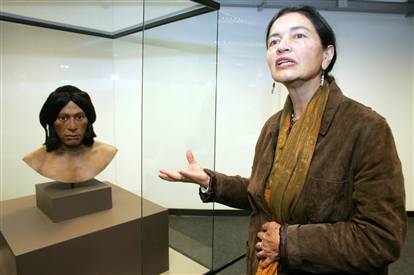
Peruvian writing system goes back 5,000 years MSNBC - July 20, 2005

Ancient culture used knots and strings to convey information
Archaeologists in Peru have found a 'quipu' on the site of the oldest city in the Americas, indicating that the device, a sophisticated arrangement of knots and strings used to convey detailed information, was in use thousands of years earlier than previously believed.
Previously the oldest known quipus, often associated with the Incas whose vast South American empire was conquered by the Spanish in the 16th century, dated from about A.D. 650.
But Ruth Shady, an archaeologist leading investigations into the Peruvian coastal city of Caral, said quipus were among a treasure trove of articles discovered at the site, which is about 5,000 years old.
"This is the oldest quipu, and it shows us that this society ... also had a system of writing¹ (which) would continue down the ages until the Inca empire and would last some 4,500 years," Shady said.
She was speaking before the opening in Lima Tuesday of an exhibition of the artifacts which shed light on Caral, which she called one of the world¹s oldest civilizations.
Found among offerings
The quipu, with its well-preserved, brown cotton strings wound around thin sticks, was found with a series of offerings including mysterious fiber balls of different sizes wrapped in ²nets² and pristine reed baskets.
"We are sure it corresponds to the period of Caral because it was found in a public building, It was an offering placed on a stairway when they decided to bury this and put down a floor to build another structure on top."
Pyramid-shaped public buildings were being built at Caral, a planned coastal city 115 miles (185 kilometers) north of Lima, at the same time that the Saqqara pyramid, the oldest in Egypt, was going up. They were were already being revamped when Egypt's Great Pyramid of Cheops (or Khufu) was under construction, Man only began living in an organized way 5,000 years ago in five points of the globe - Mesopotamia (roughly comprising modern Iraq and part of Syria), Egypt, India, China and Peru, Caral was 3,200 years older than cities of another ancient American civilization, the Maya," she added.
Caral advanced alone
Shady said no equivalent of the Rosetta Stone that deciphered the hieroglyphs of ancient Egypt had yet been found to fully unlock the language of the quipus, but said their existence pointed to a sophisticated, organized society where such information as production, taxes and debts were recorded.
They came up with their own system becausem unlike cities in the Old World which had contact with each other and exchanged knowledge and experiences, this (city) in Peru was isolated in the Americas, and advanced alone.
Caral's arid location at an altitude of 11,500 feet (3,500 meters) has helped preserve its treasures, such as piles of raw cotton - still uncombed and containing seeds, though turned a dirty brown by the ages - and a ball of cotton thread.
Shady said representations on clay figurines had helped show that nobles wore their hair in two long ponytails each side of the face, with a fringe at the front and the hair on the top of the head cropped close to the skull.
-
Inca tax man collected child sacrifices News in Science - May 30, 2005
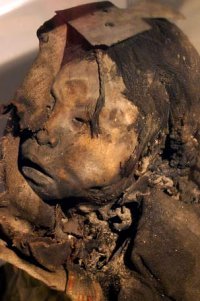
Archaeologists Uncover multi-level Tombs at Peruvian Ruins of Pachacamac Scotsman.com - May 22, 2005
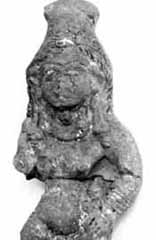
-
Giant Figures in Peru Desert Pre-date Nazca Lines Epoch Times - May 24, 2005
A group of about 50 drawings of giant figures recently discovered in the hills of Peru's southern coastal desert near the city of Palpa has been said to predate the famous Nazca lines nearby.
Mr. Johny Isla, director of the Andean Institute of Archaeological Studies, said the 'geoglyph' figures appear to have been created by the Paracas communities between 500 and 400BC, whereas the Nazca culture developed after 50 BC. Mr. Isla and his partner Dr. Markus Reindel from the Dutch Institute of Archaeology discovered the Paracas figures using aerial photography and land-based surveys. The figures of humans, birds, monkeys and cats vary in size from 10m to 50m across, and are also grouped together in areas up to 60 m to 90 m across.
The Paracas figures were created by removing dark stones in order to expose the lighter surface underneath. Some areas were cleared and others built up with rock, creating figures in high and low relief. With the Nazca lines though, the geoglyphs were only made by clearing low-relief areas. Until recently scientists believed that the figures in the Palpa and Nazca regions were only from the Nazca culture. Mr. Isla says cultural dating and style of the newly found Paracas figures sets them apart.
Mr. Isla told The Epoch Times: "Most of these geoglyphs belong to the Nazca culture but our recent studies demonstrated that there are at least 50 geoglyphs pertaining to the Paracas culture. These new figures are definitely different and older than those of the Nazca culture.
"First, the Paracas figures were drawn on the slopes of the hills, while the Nazca images were drawn in level areas. Second, the Paracas figures are smaller and were made in a naturalistic style, while the Nazca figures are bigger and stylised. Third, the Paracas figures are mostly arranged in groups, while the Nazca figures are arranged individually. Finally, it is important to note that not one of the Paracas figures were repeated in the Nazca iconography," Mr, Isla said.
Although the existence of some of the Paracas figures was previously known, most were undiscovered due to their remote location, and their visibility is highly affected by the position of the sun. One set of figures is known as the ³Temple of Fertility² as one image represents a man, another a woman and the center image seems to represent a divine figure with a head from which emanates a series of rays that end in human heads.
Mr. Isla said, "The principal idea is that together the three figures represent the reproduction of the human species, the continuity of life.² ³According to results obtained from our studies of the Nazca geoglyphs, we can suggest that the Paracas geoglyphs were made also in the context of a religious culture related to water. The Palpa and Nazca valleys are in the middle of one of the most arid deserts of the world, where the surface water is a vital resource to develop life," said Mr. Isla. Further studies may tell more about the Paracas people, their ways of life and early history of the area.
CNN - March 2005
About 50 giant figures were etched into the earth over an area of roughly 90 square miles (145 square kilometers) near the city of Palpa.
Archeologists have discovered a group of figures scraped into the hills of Peru's southern coastal desert that are believed to predate the country's famous Nazca lines.
About 50 giant figures were etched into the earth over an area of roughly 90 square miles (233 square kilometers) near the city of Palpa, El Comercio newspaper reported.
The drawings - which include human figures as well as animals such as birds, monkeys, and felines - are believed to have been created by members of the Paracas Culture sometime between 600 and 100 B.C., Johny Islas, the director of the Andean Institute of Archaeological Studies, told the newspaper.
One prominent figure appears to represent the main deity of the Paracas Culture that is commonly depicted on textiles and ceramics that date from the period, Islas said.
The recently discovered designs predate the country's famous Nazca lines that cover a 35-mile (56-kilometer) stretch of desert and have mystified scientists. They were added to the United Nations' Cultural Heritage list in 1994.
The Nazca culture flourished between 50 B.C. and 600 A.D., Islas said.
The lines - which also include pictographs of various animals - are one of Peru's top tourist attractions. About 80,000 tourists fly over the site every year.
Mummy Hair Reveals Drinking Habits Discovery - September 2004
Pre-Inca Ruins Emerging From Peru's Cloud National Geographic - September 2004
Peru's pipeline project turns up treasures MSNBC - September 2004
Incans smashed and burned temples before leaving Discovery - September 2004
Incan pilgrims smashed and burned their own temple,
and a tower containing a golden statue of a king,
rather than letting them fall into Spanish hands.
Remains of the world's largest lava flow found MSNBC - September 2004
1,300 year old city found in remote Peru jungle MSNBC - August 2004
Walled complex may have been home to 10,000 people
Scores of Inca Mummies Unearthed in Peru National Geography - March 2004
Two of the oldest mummies ever found in Peru went on display Ananova - February 2004
Incan Counting System Decoded? Discovery - February 2004
Spiritual Retreat Time.com - March 2003
Machu Picchu, long revered as a lost city of the Incas
and one of the world's most sacred places, may have
been nothing more than a royal vacation home.
Thousands of Inca mummies were found in a shanty town close to Peruvian capital, Lima in April 2002
Incan City is Found - Another Machu Picchu? - Discovery - March 2002
2004
First Andes civilization explored BBC - December 2004
A Peruvian site previously reported as the oldest city in the
Americas is a much larger complex of as many as 20 cities with
enormous pyramids and sunken circular plazas sprawled over
three river valleys.
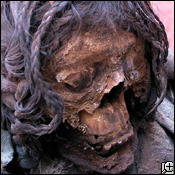 Mummy hair has revealed the first direct evidence of alcohol
consumption in ancient populations, according to new forensic
research. The study, still in its preliminary stage, examined hair
samples from spontaneously mummified remains discovered in
one of the most arid regions of the world, the Atacama Desert
of northern Chile and southern Peru.
Mummy hair has revealed the first direct evidence of alcohol
consumption in ancient populations, according to new forensic
research. The study, still in its preliminary stage, examined hair
samples from spontaneously mummified remains discovered in
one of the most arid regions of the world, the Atacama Desert
of northern Chile and southern Peru.
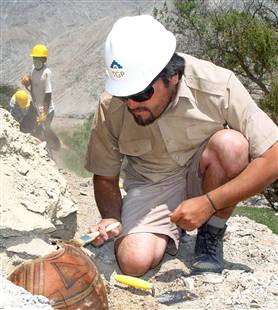 1,000 archaeological sites revealed during
excavations, tracing 9,000 years of history
1,000 archaeological sites revealed during
excavations, tracing 9,000 years of history
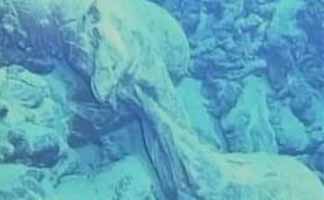
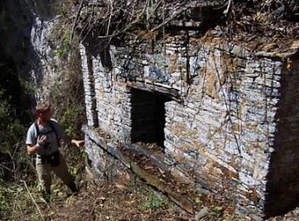 An American-led expedition has discovered five new districts
in what its leader describes as a massive metropolitan complex
spread along a river valley through thick mountainous jungle on
the eastern slope of the Peruvian Andes. It is the oldest
Chachapoyan find that we know of to date.
An American-led expedition has discovered five new districts
in what its leader describes as a massive metropolitan complex
spread along a river valley through thick mountainous jungle on
the eastern slope of the Peruvian Andes. It is the oldest
Chachapoyan find that we know of to date.
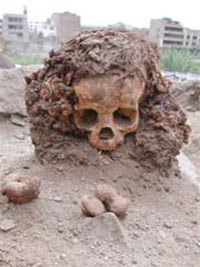 Dozens of exquisitely preserved Inca mummies are being recovered from
a barren hillside on the outskirts of Peru's bustling capitol city Lima.
Dozens of exquisitely preserved Inca mummies are being recovered from
a barren hillside on the outskirts of Peru's bustling capitol city Lima.
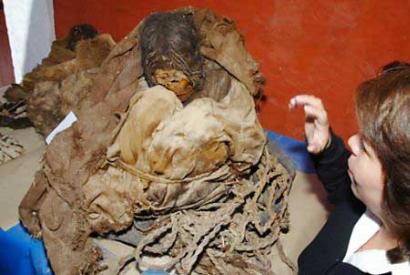
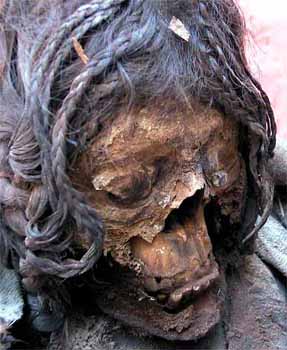
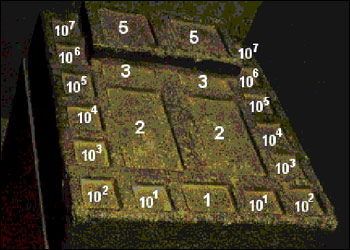 The Inca invented a powerful counting system that could be used
to make complex calculations without the tiniest mistake, according
to an Italian engineer who claims to have cracked the mathematics
of this still mysterious ancient population.
The Inca invented a powerful counting system that could be used
to make complex calculations without the tiniest mistake, according
to an Italian engineer who claims to have cracked the mathematics
of this still mysterious ancient population.
2003
Peruvian farmers learn from history BBC - May 2003
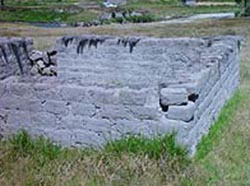 Agricultural techniques perfected by Inca farmers 500 years ago
are beginning to have a dramatic effect on the incomes of today's
farmers in Pampachiri, one of the poorest areas of Peru.
Agricultural techniques perfected by Inca farmers 500 years ago
are beginning to have a dramatic effect on the incomes of today's
farmers in Pampachiri, one of the poorest areas of Peru.
2002
First City in the New World? July 2002 - Smithsonian
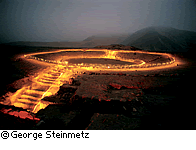 Peru's Caral suggests civilization emerged in the
Americas 1,000 years earlier than experts believed
Peru's Caral suggests civilization emerged in the
Americas 1,000 years earlier than experts believed
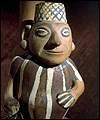
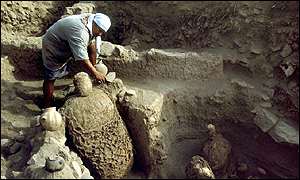
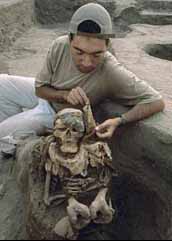
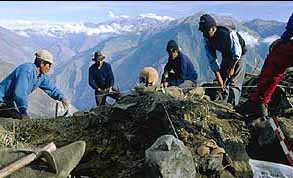
December 5, 2001 - AP - Lima
Archaeologists have unearthed what they believe was a doorway that once led into an Inca temple in the Andes Mountains.
The ancient stone portal was discovered last week 13 feet beneath a colonial-era house located near the main plaza in downtown Cuzco, National Culture Institute Director Edwin Benavente said.
Cuzco was the seat of the Incan empire that ruled Peru before the arrival of Spanish conquistadors in the 16th century. It is now the country's main tourism hub and a launching point for visiting the jungle-shrouded Incan ruins of Machu Picchu.
Benavente said the seven-foot high doorway is similar to ones found at the Sacsayhuaman, an Inca temple that sits on a hilltop overlooking Cuzco.
The portal "could have formed part of a grand complex and is probably a doorway that led to the archaeological site of Sacsayhuaman," Benavente said.
Benavente said the doorway apparently formed part of what archaeologists believe was a sacred complex in the center of ancient Cuzco, near what is now the main plaza.
Archaeologists have found a zigzagging wall similar to the one at Sacsayhuaman that is buried beneath Cuzco's modern-day buildings and that points toward the recently discovered doorway, he said.
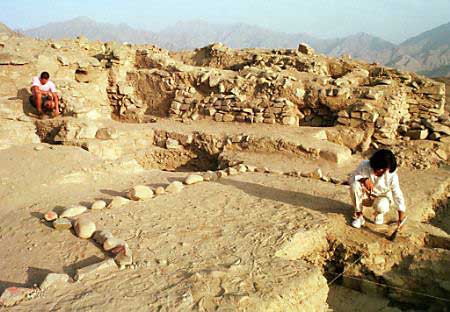
Peruvian archaeologists excavate what they believe to be the oldest city in the Americas, the sacred ruins of Caral, which lie some 120 miles north of Lima in a coastal desert between the Andes and the waters of the Pacific, in this photo taken May 11, 2001. The ruins, which have been carbon dated to some 100 years before the Great Pyramid at Giza, could provide anthropologists with a glimpse of the birth of modern society in the Americas.
May 30, 2001 - Reuters - Caral, Peru
On a scarp overlooking a lush valley carved through Peru's dusty Andean foothills, archeologists have unearthed what they believe is the oldest city in the Americas - the sacred ruins of Caral.
A team from Peru's San Marcos University has painstakingly excavated the arid hillocks above the River Supe north of Lima to reveal six ancient pyramids, an amphitheater and residential complex that they have dated to as early as 2627 BC.
"In these structures of stone, mud and tree trunks we find the cradle of American civilization,'' said Ruth Shady, who is leading the excavations.
The discovery is already being hailed as the most exciting find in Peru since 1911, when Yale archeologist Hiram Bingham stumbled on the ruined Inca citadel of Machu Picchu hidden in the clouds of the craggy Andean highlands.
Anthropologists working at Caral believe the windswept ruins 14 miles from the Pacific will provide a glimpse of the birth of urban society in the Americas and may challenge theories that the earliest civilizations settled by the sea.
They say a priestly society built the stone structures here without the aid of wheels or metal tools almost a century before the Egyptians erected the Great Pyramid at Giza.
The remains, some 120 miles north of Lima in a coastal desert between the Andes and the Pacific, predate Machu Picchu by three millennia and are some 1,100 years older than Olmec in Mexico, the oldest city in the Americas outside Peru.
``I hope this will help Peruvians understand their history,'' said dust-caked archeologist Rodolfo Peralta, 31, standing atop the biggest pyramid, which is some 60 feet high and a staggering 500 feet long.
``Otherwise people will think our history is just a tale of being conquered by the Spanish,'' he said.
Riddle Of Abandonment
Up to 10,000 people may once have inhabited the 160-acre site at Caral, archeologists believe, and its construction suggests a regional capital with urban planning, centralized decision making and a structured labor force.
Now Andean Indians -- including women with braids, black hats and traditional colored skirts - carve out a livelihood tending goats and growing corn beside the dirt track that connects Caral to the nearest town an hour's drive away.
Despite the hardships of working in the blazing sun and living in an isolated farmhouse with no electricity or running water, the sunburned, bearded Peralta brims with enthusiasm.
For a nation subjugated by 16th century Spanish conquistadors, who ransacked its rich indigenous culture in a frenzied lust for gold, such discoveries testify to the long heritage of what Europeans dubbed the ``New World.''
The once-in-a-lifetime find has sparked acrimony in the international academic community. Shady accuses U.S. anthropologist Jonathan Haas of Chicago's Field Museum of trying to steal the credit for seven years of her hard work.
``The problem is that he has now presented Caral as his discovery, when my team has been investigating here since 1994, sleeping on the ground and working tirelessly to uncover it,'' an irate Shady said in her cluttered Lima office.
Haas helped Shady carbon date reed matting from Caral last year after he became interested in the site in 1996. The two co-wrote a paper in the April edition of Science magazine.
``I think there has been a misunderstanding. ... I never wanted to take any credit from Ruth for her discovery,'' Haas told Reuters by telephone from Chicago, adding U.S. media had played up his role.
One of the many riddles now confronting archeologists at Caral is why the inhabitants abandoned the settlement. Like all pre-conquest civilizations in Peru, the people here left no written records and the settlement at Caral was too early even to have ceramics or more than the most basic tools.
``One theory is that a drought produced a famine, which forced the city dwellers to move on,'' said Peralta, noting residents painted many buildings black in the final stage of habitation, after originally coloring them white for purity.
Subsequent civilizations never occupied the site but apparently revered it, leaving gold and silver offerings at its perimeters. South America's most advanced pre-conquest civilization, the Incas, built temples on its outskirts.
Inhabitants of Caral also apparently believed the buildings were divine, dotting their homes and temples with tiny alcoves filled with dried-mud figurines and small sacred bonfires. Excavations have also exhumed a skeleton from the walls of one home, which was buried there rather than sacrificed.
Burying The Dead
As with the Mayans who ruled Mexico, Guatemala and Honduras around AD 300, the construction of religious pyramids suggest the existence of a theocracy, but the inhabitants of Caral differed by living in their ceremonial centers, Peralta said.
Rooms and courtyards on top of the terraced mounds suggests they had both religious and administrative purposes. Varied housing also suggest a stratified society, with different residential areas for the priestly and laboring classes.
There are also signs Caral had the earliest known system of crop irrigation in the Americas. Coastal artifacts, including 32 pipes made of pelican bones and copious anchovy and sardine bones, suggest the residents may have traded their cotton and fruit crops with fishing communities in return for food.
Researchers expect to learn much more about the daily lives of the people when they discover the city's cemetery.
``You can tell a lot from a culture from the way they bury their dead,'' Peralta said as the sun set behind a pyramid over corn fields in the valley below.
ALPHABETICAL INDEX OF ALL FILES